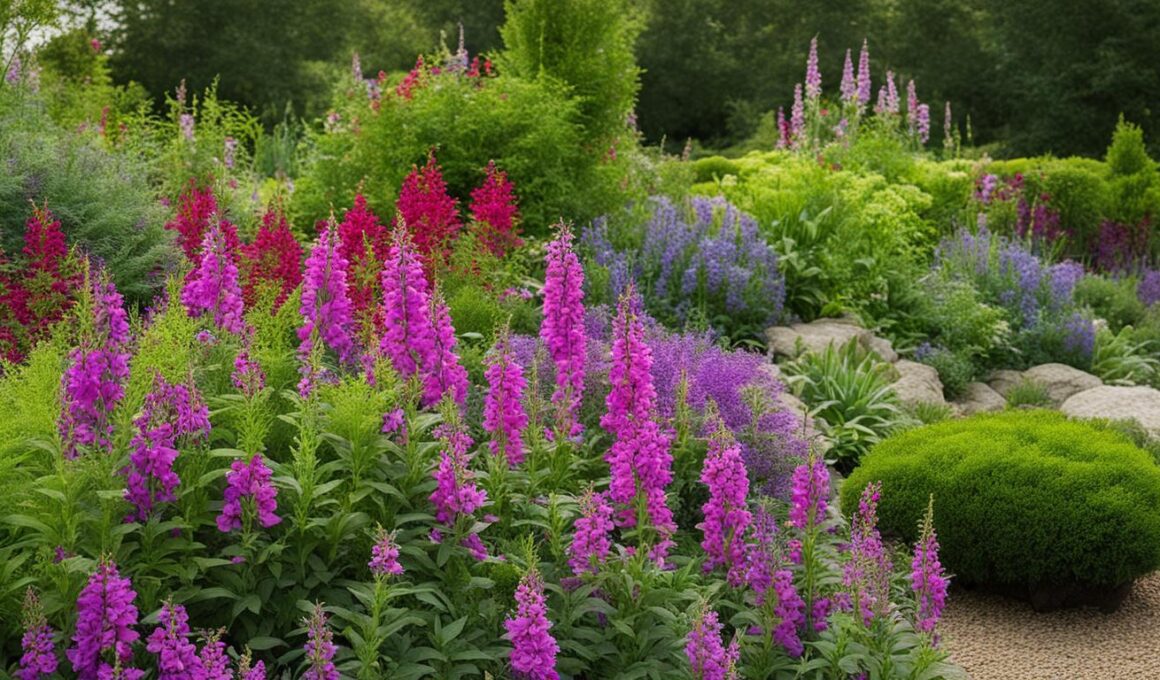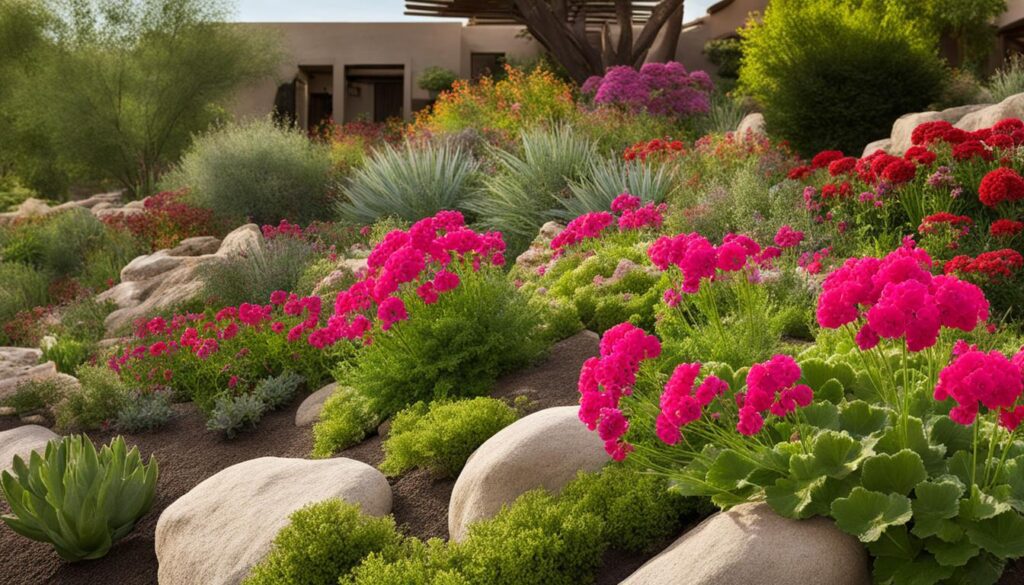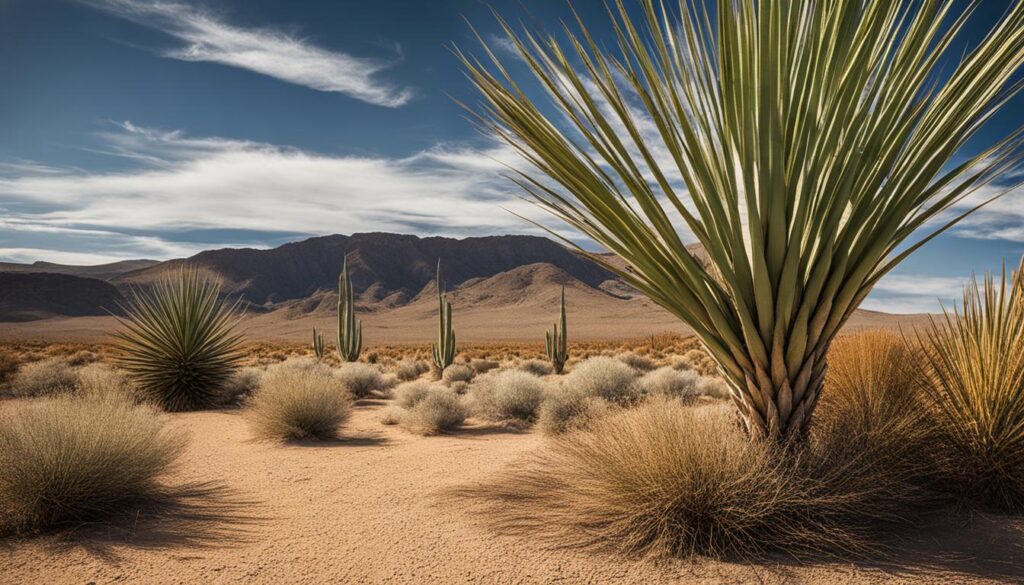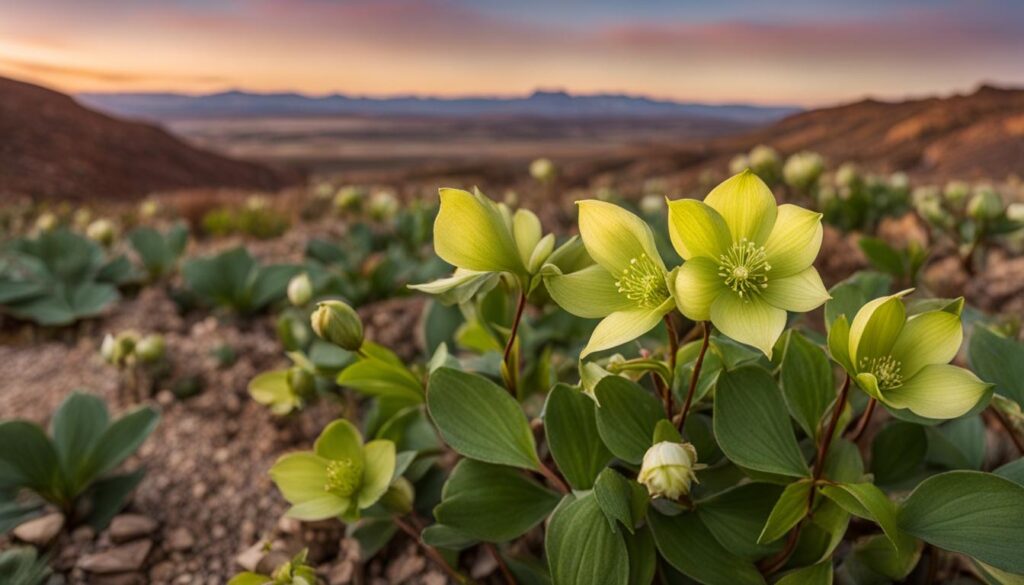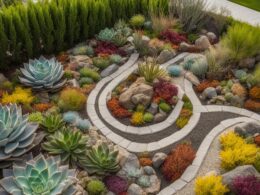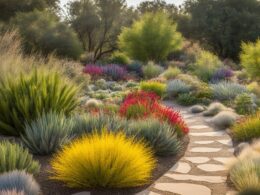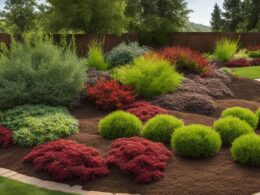Xeriscaping, also known as climate-appropriate planting, is a landscaping technique that focuses on conserving water and protecting the environment. Contrary to popular belief, xeriscaping does not mean only using desert plants or completely eliminating water. With the right xeriscaping plants, you can create a lush and beautiful garden while minimizing water usage. This article will explore 10 climate-appropriate plants for xeriscaping, including penstemon spectabilis, lomandra, pelargoniums, yucca, helleborus argutifolius, sempervivums, sedum, manzanita, eschscholzia, and lupins.
Penstemon Spectabilis
Penstemon spectabilis is a beautiful blue-flowering perennial that can withstand extreme heat. It is native to southern California and is perfect for xeriscaping. This plant is an excellent choice for mass drift plantings and attracting pollinators such as hummingbirds and bees. It thrives in full sun and requires little watering or maintenance.
Key Takeaways:
- Penstemon spectabilis is a drought-tolerant xeriscaping plant.
- It has striking blue flowers and can withstand extreme heat.
- Penstemon spectabilis attracts pollinators like hummingbirds and bees.
- This plant requires little watering and maintenance.
- It is native to southern California.
Penstemon Spectabilis
Penstemon spectabilis is a stunning xeriscaping plant that will add beauty and charm to your garden. Known for its vibrant blue flowers, this drought-tolerant perennial is a perfect choice for creating a water-saving landscape. Native to southern California, penstemon spectabilis is well-adapted to hot and arid climates, making it an ideal addition to your xeriscape garden.
This plant thrives in full sun and requires minimal watering. Its ability to withstand extreme heat and dry conditions makes it an excellent choice for conserving water in your garden. Additionally, penstemon spectabilis is known for attracting pollinators such as hummingbirds and bees, adding life and movement to your outdoor space.
Penstemon spectabilis is a beautiful blue-flowering perennial that can withstand extreme heat. It is native to southern California and is perfect for xeriscaping. This plant is an excellent choice for mass drift plantings and attracting pollinators such as hummingbirds and bees. It thrives in full sun and requires little watering or maintenance.
With its stunning blooms, low water requirements, and ability to attract pollinators, penstemon spectabilis is a must-have plant for any xeriscaping project. Incorporate it into your landscape design to create a visually appealing and eco-friendly garden that will thrive even in the driest of conditions.
Lomandra: Xeriscaping with Grassy Foliage
When it comes to xeriscaping, one plant that deserves a place in your water-wise garden is Lomandra. This Australian native is known for its beautiful grassy foliage, making it an excellent choice for adding texture and visual interest to your landscape. With its ability to thrive in both sunny and shady conditions, as well as its tolerance for dry spells, Lomandra is a versatile and drought-tolerant plant.
The varieties ‘Lime tuft’ and ‘Platinum Beauty’ offer stunning green and white foliage options, respectively, adding a touch of elegance to your xeriscape. Whether used as a border plant or as a ground cover, Lomandra creates a lush and vibrant display with minimal water requirements. Its low-maintenance nature makes it ideal for those who want a beautiful garden without the hassle of constant watering and maintenance.
By incorporating Lomandra into your xeriscape design, you can achieve an eco-friendly and sustainable landscape that not only conserves water but also provides year-round beauty. Its hardy nature and ability to withstand various growing conditions make it a reliable choice for those looking to transform their outdoor space into a water-saving haven.
The Benefits of Using Lomandra in Xeriscaping:
- Grassy foliage adds texture and visual interest to your landscape.
- Tolerates both sunny and shady conditions.
- Requires minimal watering, making it ideal for water-wise gardens.
- Versatile plant that can be used as a border plant or ground cover.
- Low-maintenance nature reduces the need for constant care.
With its striking grassy foliage and ability to thrive in drought-like conditions, Lomandra is a standout choice for any xeriscape garden. Embrace this Australian native plant and create a sustainable landscape that not only conserves water but also enhances the beauty of your outdoor space.
Pelargoniums: Adding Color and Scent to Your Xeriscaping Garden
When it comes to xeriscaping plants, pelargoniums are a fantastic choice for adding vibrant color and delightful scents to your garden. Also known as geraniums, these versatile plants come in a variety of types, offering a wide range of colors and foliage options. Whether you prefer the grey-green leaves or variegated cultivars, you can find pelargoniums that suit your taste and complement your xeriscape design.
Pelargoniums are not only visually appealing but also serve practical purposes in your garden. They make excellent garden edging plants, adding definition and structure to your landscaping. Additionally, their repeated bursts of color create a visually pleasing rhythm in water-wise planting areas. By incorporating pelargoniums into your xeriscaping garden, you can introduce a touch of elegance and charm while maintaining a low-water landscape.
Key Features of Pelargoniums:
- Wide range of colors and foliage options
- Fragrant flowers that attract pollinators
- Excellent as garden edging plants
- Repeated bursts of color for visual interest
- Low-water landscaping option
Pelargoniums, commonly known as geraniums, are versatile xeriscaping plants that can add both color and scent to your garden.
Whether you choose pelargoniums with white, red, or vibrant pink blossoms, their flowers will draw the attention of pollinators like bees and butterflies to your garden. The lovely fragrance emitted by these plants further enhances the overall sensory experience. Imagine strolling through your xeriscape garden and being greeted by a delightful blend of colors and scents.
With their ability to thrive in low-water conditions, pelargoniums are an eco-friendly choice for water-wise landscaping. By incorporating these drought-tolerant plants into your garden, you can create a sustainable and visually appealing oasis that will be the envy of your neighbors.
Yucca: Creating Architectural Statements with Drought-Tolerant Plants
When it comes to xeriscaping plants that make a bold statement in your landscape, yuccas are hard to beat. These architectural wonders bring a unique and striking presence to gardens, making them an excellent choice for creating focal points and adding visual interest. With their starburst form and sword-like leaves, yuccas add a touch of drama and elegance to any outdoor space.
One of the greatest advantages of yuccas is their ability to thrive in drought-prone areas. These plants are incredibly adaptable and can withstand harsh conditions, making them ideal for xeriscaping projects. Whether you live in a region with limited rainfall or simply want to conserve water, incorporating yuccas into your landscape is a smart and sustainable choice.
Yuccas are also highly versatile and can adapt to various growing conditions. They can tolerate sharply drained soil, full sun, and even dry shade, making them suitable for a wide range of garden settings. Whether you’re looking to enhance a sunny border or add interest to a shaded corner, yuccas are the perfect solution.
Yucca Varieties for Xeriscaping:
- Yucca rostrata: Also known as the Beaked Yucca, this variety features a striking trunk with dense clusters of blue-green leaves that form a crown at the top.
- Yucca gloriosa: The Spanish Dagger is a classic choice with sword-like leaves and tall flower spikes that add height and texture to the landscape.
- Yucca gloriosa ‘Bright Star’: This variegated cultivar offers striking yellow and green foliage, adding a pop of color to your xeriscape garden.
With their stunning silhouettes and ability to thrive in challenging conditions, yuccas are an excellent addition to any xeriscaping project. By incorporating these architectural plants into your landscape, you can create a visually appealing outdoor space that is both sustainable and low-maintenance.
Helleborus Argutifolius: A Stunning Xeriscaping Plant for Dry Shade with Winter Interest
If you’re looking for a xeriscaping plant that can thrive in dry shade and add winter interest to your garden, look no further than Helleborus Argutifolius. Also known as Corsican hellebore, this Mediterranean plant is the perfect addition to your water-wise landscape. Its ability to tolerate low watering and poor soils makes it ideal for xeriscaping gardens, where water conservation is a priority.
Helleborus Argutifolius blooms in late winter and early spring, producing vibrant lime green flowers that add a pop of color to the garden during the low season. These flowers not only brighten up the landscape but also attract early pollinators, such as bees and butterflies, when little else is in bloom. The tough evergreen foliage of Helleborus Argutifolius provides excellent architectural quality and remains intact throughout the year, ensuring your garden looks beautiful even in the colder months.
When planting Helleborus Argutifolius, make sure to choose a location with dry shade conditions, as this plant thrives in such environments. It can adapt to a variety of soil types, including sandy and clay soils, as well as compacted soils. This adaptability makes Helleborus Argutifolius an excellent choice for areas where other plants may struggle, such as under trees or in the shadow of buildings.
Key Features of Helleborus Argutifolius:
- Tolerant of low watering and poor soils
- Produces vibrant lime green flowers in late winter and early spring
- Attracts pollinators such as bees and butterflies
- Offers tough evergreen foliage for architectural interest
- Thrives in dry shade conditions
- Adapts to various soil types
With its ability to thrive in dry shade, its stunning winter blooms, and its tolerance of low watering, Helleborus Argutifolius is a must-have xeriscaping plant. Add this Mediterranean beauty to your garden to create a sustainable and visually appealing landscape that will impress year-round.
What are the Best Climate-Appropriate Plants for Xeriscaping to Transform my Landscape?
Transform your garden with xeriscaping by incorporating climate-appropriate plants like succulents, agave, yucca, and lavender. These plants require minimal water, making them perfect for xeriscaping. They will thrive in hot, dry climates and add unique beauty to your landscape while conserving water.
Sempervivums: The Perfect Ground Cover for Xeriscaping Gardens
If you’re looking for a low-maintenance and visually striking ground cover for your xeriscaping garden, sempervivums are an excellent choice. Also known as houseleeks or hens and chicks, these evergreen succulents offer a unique and intricate patterned display that adds texture and interest to your landscape.
Sempervivums come in a variety of colors and textures, with rosettes that range from green to red, blue to purple. Their compact size and ability to spread make them ideal for filling in gaps between larger plants or covering bare ground. These resilient succulents are drought-tolerant, meaning they can withstand long periods without water and thrive in sandy or well-draining soil.
Why Choose Sempervivums for Your Xeriscaping Garden?
“Sempervivums not only provide an attractive ground cover but also help to control erosion in xeriscaping gardens. Their shallow root systems knit together, creating a protective barrier against soil erosion caused by heavy rain or wind.”
In addition to their beauty and hardiness, sempervivums are easy to care for. They require minimal watering, making them perfect for water-wise landscapes. These low-maintenance plants can tolerate a range of growing conditions, from full sun to partial shade, and are resistant to pests and diseases. Once established, sempervivums will continue to thrive and spread, requiring little intervention.
Tips for Growing Sempervivums
- Plant them in well-draining soil to prevent root rot.
- Allow the soil to dry out completely between waterings.
- Provide full sun to promote vibrant colors in the rosettes.
- Divide and replant sempervivums every few years to control their spread and rejuvenate the plants.
With their stunning appearance and low-maintenance nature, sempervivums are an ideal ground cover choice for xeriscaping gardens. Their ability to thrive in harsh conditions while adding beauty and texture makes them a valuable addition to any water-wise landscape.
What Are the Best Climate-Appropriate Plants for Xeriscape Landscaping?
When designing native xeriscape landscaping plants, consider options like yucca, agave, and lavender. These resilient plants thrive in low-water conditions, making them ideal for drought-prone climates. Embrace their natural beauty and ability to withstand harsh environmental conditions.
What Are Some Climate-Appropriate Native Plants for Xeriscaping in Cold Climates?
When considering xeriscaping in cold climates, choosing the ultimate native plants can be essential. Some climate-appropriate options include blue grama grass, feather reed grass, and butterfly weed. These plants are well-adapted to drought conditions and can thrive in colder regions, making them perfect for xeriscaping projects.
Conclusion
Xeriscaping is a landscaping technique that focuses on using climate-appropriate plants to create water-saving landscapes. By choosing drought-tolerant plants and implementing water-conserving principles, you can transform your landscape into a beautiful, eco-friendly oasis.
The 10 climate-appropriate plants mentioned in this article are just a taste of the many options available for xeriscaping. With proper planning and plant selection, you can create a sustainable garden that requires minimal intervention and watering while still enjoying lush beauty.
So, why wait? Start transforming your landscape today with the power of xeriscaping. Embrace the benefits of water-saving landscapes and make a positive impact on the environment. With the right combination of climate-appropriate plants, you can have a stunning garden that not only enhances the beauty of your surroundings but also conserves water for future generations. Transforming your landscape has never been easier!





